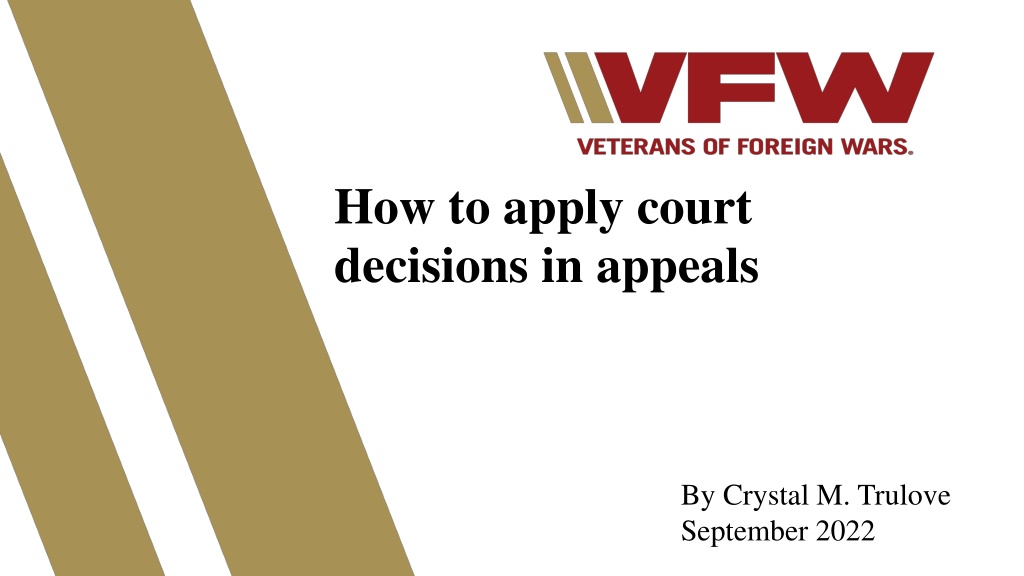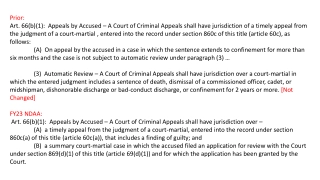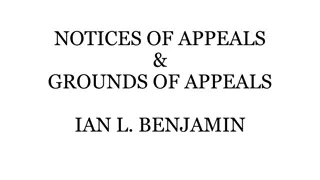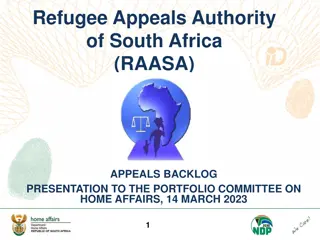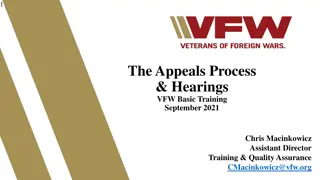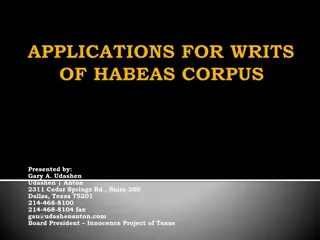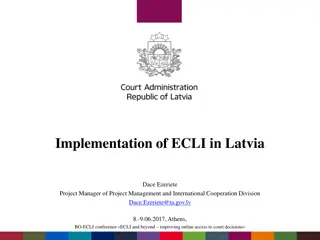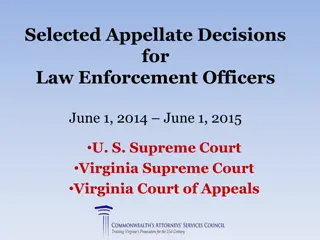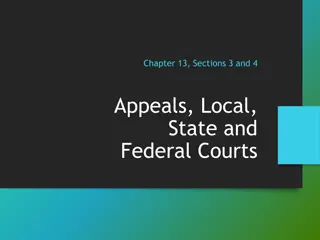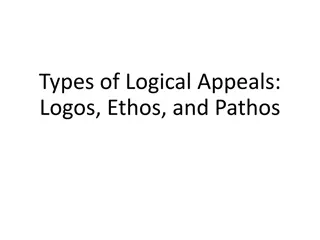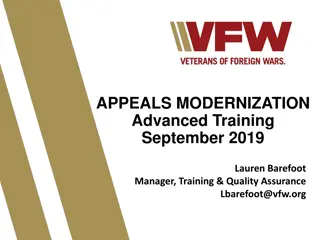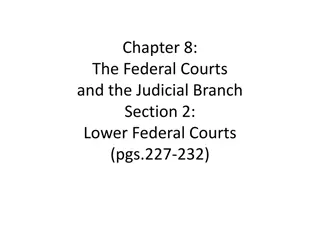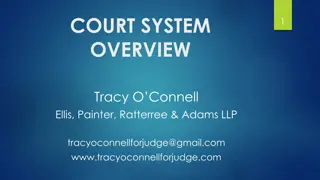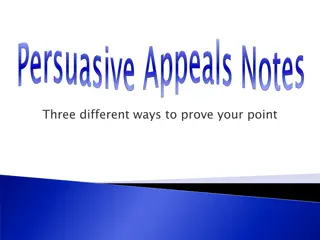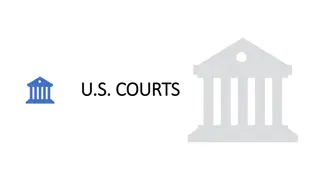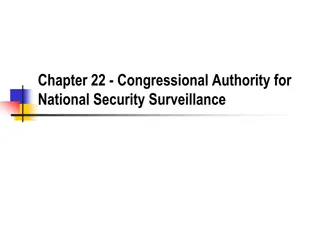Applying Court Decisions in Appeals
In this resource by Crystal M. Trulove, learn how to effectively apply court decisions in appeals, particularly focusing on the United States Court of Appeals for the Federal Circuit (CAFC) and the United States Court of Appeals for Veterans Claims (CAVC). Understand the setup of these courts, the significance of precedent, and how decisions are categorized as precedential or nonprecedential. Gain insights into why court cases are essential and how to utilize them in legal proceedings.
Download Presentation

Please find below an Image/Link to download the presentation.
The content on the website is provided AS IS for your information and personal use only. It may not be sold, licensed, or shared on other websites without obtaining consent from the author.If you encounter any issues during the download, it is possible that the publisher has removed the file from their server.
You are allowed to download the files provided on this website for personal or commercial use, subject to the condition that they are used lawfully. All files are the property of their respective owners.
The content on the website is provided AS IS for your information and personal use only. It may not be sold, licensed, or shared on other websites without obtaining consent from the author.
E N D
Presentation Transcript
How to apply court decisions in appeals By Crystal M. Trulove September 2022
Introduction Crystal M. Trulove crystal.trulove@gmail.com Air Force Veterans Affairs RVSR DRO 2
References https://efiling.uscourts.cavc.gov/ http://www.cafc.uscourts.gov/ 38 CFR 3.102 Reasonable Doubt 38 CFR 3.159 Department of Veterans Affairs assistance in developing claims. 38 CFR 3.326 Examinations 38 CFR 4.1 Essentials of Evaluative Rating 38 CFR 4.10 Functional Impairment 38 CFR 4.13 Effect of Change of Diagnosis 38 CFR 4.2 Interpretation of Examination Reports 38 CFR 4.3 Resolution of Reasonable Doubt 3
Refences continued M21-1 I.i.1.A.4.e. Competent Lay Evidence M21-1 IV.i.1.B. Evidentiary Standards for finding and Examination for Opinion Necessary M21-1 IV.i.3.C.1.b. Handling Insufficient Examination Reports M21-1 V.ii.1.A.1.j. Reasonable Doubt Rule M21-1 V.ii.1.A.2.i. Court Holdings on Negative Evidence and the Duty to Assist M21-1 V.ii.1.A.3.g. A medical opinion is a conclusion supported by evidence M21-1 V.ii.1.B. Reviewing Testimony and Lay Evidence M21-1 V.ii.3.C.2.c. Impact of Saunders v. Wilkie on Diagnoses of Pain M21-1 V.iii.13.1.b. Applying Guidance on Sympathetic Reading to Mental Disorders Claims 4
Why use Court Cases? Course Objectives: Understand 8 important court decisions Understand precedent Understand how to use these decision in appeals Know where to look up court decisions 5
Setup of the courts United States Court of Appeals for the Federal Circuit (CAFC) 12 judges appointed for life by the President Appeals to the court come from all U.S. federal district courts, including: United States CAVC and more (trademarks, patents, Armed Services, Postal Service, international trade, etc.) Decisions are binding precedent throughout the U.S. United States Court of Appeals for Veterans Claims (CAVC) 12 judges appointed for life by the President Exclusive jurisdiction to review decisions of the BVA If the panel determines that its decision will add significantly to a body of law, it issues a precedential opinion. Otherwise, they are issued as nonprecedential. 7
CAVC Precedent Precedent: A legal decision made by a court of authority, which serves as an authoritative rule in future, similar cases. https://legaldictionary.net/precedent/ If the panel determines that its decision will add significantly to a body of law, it issues a precedential opinion. Otherwise, they are issued as nonprecedential. A decision is precedential if there is no heading at the top saying Not Published or Designated for Electronic Publication. 8
Benefit of the Doubt Gilbert v Derwinski (decided October 12, 1990) Considers three statutory provisions of VA law: 1. clearly erroneous 2. benefit of the doubt 3. reasons or bases 10
Benefit of the Doubt 38 CFR 3.102 Reasonable Doubt This rule does not ease the veteran s initial burden of proof, and the submission of a valid claim is necessary. Once VA has assisted the veteran with obtaining evidence and completing the claim, THEN the evidence is weighed. Baseball analogy A veteran need only demonstrate that there is an approximate balance of positive and negative evidence in order to prevail. It is not a means of reconciling conflict or contradiction within the evidence. 38 CFR 4.3 Resolution of Reasonable Doubt Applied just to degree of disability 11
Reasons or Bases M21-1 V.iv.1.A.5.a. Purpose of the Reasons for Decision A decision of the Board shall be in writing and contain findings of fact and conclusions of law separately stated and include reasons and bases Will permit a claimant to understand the Board s response to the claim 12
More helpful information Extra! Gilbert v. Derwinski A finding is clearly erroneous when although there is evidence to support it, the reviewing court on the entire evidence is left with the definite and firm conviction that a mistake has been committed. 13
Example Scenario Veteran s DD214 states that she worked in personnel and administration at HHS in the Marines. VA denied her HL claim stating that the job has a low probability of noise exposure. Her claim was that she had to fill in as one of the trainers at field artillery training for three weeks. Her file contains a buddy statement from another Marine who was a trainer with her. Would the Benefit of the Doubt Rule apply? 14
Accepting Lay testimony Barr v. Nicholson (decided June 15, 2007) Veteran is competent to report observable symptoms In certain circumstances, lay evidence of a nexus between the present disability and post service symptomatology meets criteria. 15
Accepting Lay testimony 38 CFR 3.159(a)(2) & M21-1 V.ii.1.B.2.b. Lay evidence is generally afforded probative value if it is provided by a person who has knowledge of facts or circumstances and conveys matters that can be observed and described by a lay person. A medically-untrained individual is not usually competent to offer a medical opinion regarding the etiology of disorders and such an opinion is generally assigned little probative weight. 16
More helpful Information Extra! Barr v. Nicholson When VA provides an exam even if it didn t have to the exam must be adequate 17
Example scenario Veteran tells you he wants to make a claim for SC of chronic diarrhea, but he has no medical diagnosis. In Barr, CAVC explained that because varicose veins may be diagnosed by their unique and readily identifiable features, determining the presence of varicose veins is not medical in nature and can be made through lay observation. Could diarrhea fall under the same criteria? 18
Lay Evidence Clemons v. Shinseki (Decided February 17, 2009) Adjudication of the claim does not end in the face of currently diagnosed mental conditions that are different from the lay hypothesis Claim for any mental health condition is a claim for all mental health conditions relevant to veteran s case 19
Lay Evidence M21-1 I.i.1.A.4.e. & 38 CFR 3.159(a)(2) Competent Lay Evidence Any evidence not requiring that the proponent have specialized education, training, or experience. Lay evidence is competent if it is provided by a person who has knowledge of facts or circumstances and conveys matters that can be observed and described by a lay person. M21-1 V.iii.13.1.b. Applying Guidance on Sympathetic Reading to Mental Disorders Claims 20
Example Scenario Veteran made a claim for Generalized Anxiety Disorder. VA requested a mental health examination, where the examiner diagnosed Substance Use DO. VA denied the claim with the rationale that there was no diagnosis of GAD, therefore GAD could not be granted SC. Is the CAVC decision on Clemons relevant in this veteran s appeal? 21
Nexus has low threshold McLendon v. Nicholson (decided June 5, 2006) If the first two elements are of record, evidence that suggests a nexus but remains unclear still triggers VA duty to assist in obtaining a medical examination if evidence shows the condition may be associated with service. Ex. Paratrooper with arthritic knees 22
Nexus has low threshold 38 CFR 3.159(c)(4)(i)(C) Three criteria for a valid claim: i. Event in service ii. Current disability iii. Nexus between the two (not limited to medical evidence) A fourth criteria that triggers an exam: iv. Inadequate medical evidence in file Determine whether evidence indicates that a disability, or persistent or recurrent symptoms of a disability, may be associated with the claimant s service or with a service-connected disability. This is a low threshold. 23
More helpful information Extra! McLendon v. Nicholson Adjudicators cannot arbitrarily determine in-service injuries to be acute and transitory without relying on competent medical evidence determining that chronic disability was not demonstrated. 24
Example scenario Veteran was stationed at Elmendorf AFB in Anchorage, AK. She claims that on one occasion, she slipped on ice and landed hard on her hip. She did not go to the doctor at the time, but states that she has had a lot of pain in her hip joint ever since the fall. Does evidence show condition may be associated with service? Why? Does the statement suggest a nexus? 25
Inadequate medical opinion Stefl v. Nicholson (decided March 27, 2007) Medical opinion regarding direct service connection is required even if condition does not meet presumptive criteria Medical opinions without rationale/analysis are inadequate 26
Inadequate medical opinion M21-1 V.ii.1.A.3.g. A medical opinion is a conclusion supported by evidence. In Stefl, the opinion that the condition was not related to AO exposure may be correct, but the rational was inadequate. Presumptive conditions are those which VA finds have a positive association with exposure to herbicides. It does not preclude those conditions from being considered for direct service connection, even on a basis of exposure to herbicide. For each condition on the list, someone had to determine the positive association in the first place 27
Medical opinions Nieves-Rodriguez v Peake(Decided December 1, 2008) The value of a medical opinion is based in the sound reasoning provided and not in the fact that the file was reviewed. 28
Medical opinions CAVC held that the probative value of a medical opinion primarily comes from the physician s reasoning. Review of claims file is not required Therefore, duty to assist doesn t include this Private Physician s opinion shouldn t automatically have less weight VA can reject a private physician s opinion, as long as a rationale is provided. 29
More helpful information Extra! Nieves-Rodriguez v Peake Duty to assist does not include informing every veteran of the availability of the claims file 30
Example scenario Veteran s claim was denied, even though her private doctor provided a medical opinion. You look at the letter from VA and you see that there was one positive opinion with a rationale from the private doctor, and one negative opinion with a rationale from the VA examiner. Is Nieves-Rodrigues v Peak applicable? What other court case comes to mind? 31
Pain as a disability Saunders v. Wilkie (CAFC) (Decided April 3, 2018) Pain alone can be a functional impairment warranting service connection Disability refers to functional impairment and not necessarily the underlying cause (diagnosis) 32
Pain as a disability M21-1V.ii.3.C.2.c. Impact of Saunders v. Wilkie on Diagnoses of Pain Pain, even in the absence of a presently diagnosed condition, can cause functional impairment. To establish the presence of a disability, a veteran needs to demonstrate that the pain reaches the level of a functional impairment of earning capacity. 33
Rating Reductions Brown v. Brown (Decided August 16, 1993) Evaluation cannot be reduced without finding improvement in ability to function under the ordinary conditions of life even if in effect for less than 5 years Ratings in effect for 5 years or more cannot be reduced after one exam 34
Rating Reductions Brown v. Brown (Continued) Examinations less full and complete than those used to determine an evaluation cannot be used to reduce an evaluation. Ratings for episodic conditions such as asthma cannot be reduced after only one examination. 35
Rating Reductions M21-1 X.ii.4.A.1.b. Evidentiary Standard for Reduction Due to Improvement shown by a thorough examination adequate for rating purposes, and reflects an improvement in ability to function under the ordinary conditions of life, including employment. 36
More helpful information Extra! Brown v Brown Effective dates for determining the 5-year period are based on the actual, assigned effective dates, not on the day the decision was made to assign an effective date. 37
Example scenario Veteran has been SC for MDD at 70% for six years. With social security benefits, the income allows her to work part time. She is claiming IU, and just saw her results from a mental health exam where the examiner said she is doing well. The veteran calls you, worried that VA will reduce her evaluation. What can you tell her? 38
Practical Exercises Ruma Nandini claim for throat cancer denied Jeremy Li claim for cirrhosis of the liver denied Celia Clark claim for patellar tendinitis of the left knee denied 39
Questions? Crystal M. Trulove crystal.trulove@gmail.com
